This post is in two parts. This week I shall look at the role of Margaret Dashwood, firstly, in Jane Austen’s Sense & Sensibility and then I’ll contrast it with Emma Thompson’s depiction of Margaret Dashwood in her Screenplay of Sense & Sensibility which won the 1996 Academy Award for Best Screenplay, as well as earning Emma Thompson an Oscar for Best Adapted Screenplay. The differences are interesting.

19th century glass inkwell
First, though, a quick outline of Sense & Sensibility. Mrs Dashwood and her three daughters: sensible Elinor, the over-romantic Marianne, and Margaret, are left in straitened circumstances when their father dies. They must leave their treasured home, Norland Park. Mrs Dashwood’s cousin, Sir John Middleton, offers them a cottage on his estate in Devonshire, which they accept gratefully.
Whilst still at Norland, Elinor meets Edward Ferrars, her sister-in-law’s brother, and the attraction is mutual – but Edward is curiously restrained. The Dashwoods are now settled at Barton Cottage, where Marianne meets the dashing Willoughby, heir to Allenham Court, and they fall passionately in love. It looks like a match, but underneath his charming exterior, Willoughby is a man of few principles and he abandons Marianne for an heiress and breaks her heart.
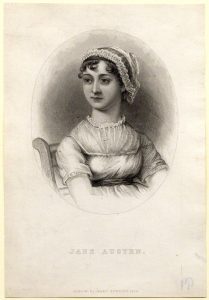
Sense and Sensibility (1811),was the first of Jane Austen’s novels to be published. It concerns the fortunes of the two older Dashwood girls, Elinor and Marianne.
Jane Austen introduces them thus: Elinor, aged nineteen, possessed ‘a strength of understanding and coolness of judgement . . . She had an excellent heart, her disposition was affectionate and her feelings were strong, but she knew how to govern them.’ Plainly, Elinor is the sensible one.
Marianne, only sixteen at the beginning of the book, ‘was sensible and clever, but eager in everything: her sorrows, her joys, could have no moderation. She was generous, amiable, interesting; she was everything but prudent.’ She is obviously a girl who wears her heart on her sleeve.
Margaret, the youngest daughter, gets only one sentence. ‘Margaret, the other sister, was a good-humoured, well-disposed girl; but as she had already imbibed a good deal of Marianne’s romance, without having much of her sense, she did not, at thirteen, bid fair to equal her sisters at a more advanced period of life.’

19th century writing desk – plus inkwell
This is, surely, somewhat dismissive, and I couldn’t help feeling that Jane Austen doesn’t much like Margaret. She is thirteen, and Jane Austen gives her very little to do or say. I couldn’t help wondering why she was there at all. She is entirely absent for a hundred and eighty-four pages (Chapters 25 – 46), when Elinor and Marianne go to London to stay with Mrs Jennings.
In the first TV adaptation I saw of Sense and Sensibility, she was omitted completely.
It is very unlike Jane Austen to create a character who seems so superfluous to requirements.
So, why is Margaret there? As ‘the whole country about them abounded in beautiful walks,’ Margaret is useful as a companion for Marianne when they set out to explore the surroundings of their new Devonshire home. When it suddenly comes on the rain, the girls start to run ‘with all possible speed’ down the hill – something they obviously enjoy. But Marianne trips and falls and is rescued by the charming and handsome Mr Willoughby, who picks her up and carries her back to Barton Cottage. Margaret calls Willoughby, somewhat romantically, ‘Marianne’s preserver’ but we are only told this – we don’t hear it for ourselves – which is less emotionally involving.
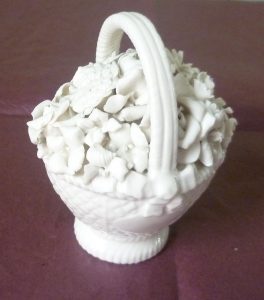
China basket of flowers
It is Margaret who sees Willoughby cutting off a lock of Marianne’s hair and tells Elinor: ‘Last night, after tea, when you and mamma went out of the room, they were whispering and talking together and he seemed to be begging something of her, and presently he took up her scissors and cut off a long lock of her hair, for it was all tumbled down her back; and he kissed it, and folded it up in a piece of white paper and put it into his pocket-book.’
It is natural for a thirteen-year-old girl to be curious about love. If she’d been older, she might have been accused of prurience – as Nancy Steele is later, for eaves-dropping on the conversation between Edward Ferrars and Lucy Steele, but Margaret’s openness in telling Elinor shows her innocence. She’s fascinated by matters relating to love and her account is very precise – one feels it can be trusted.
Margaret, however, goes way beyond what is acceptable by hinting to the nosy Mrs Jennings that she, Margaret, knows all about Elinor’s young man. And Marianne’s well-meant but unwise intervention pushes Margaret into saying ‘that his name begins with an F.’ to everyone’s great hilarity – except for Elinor who is deeply distressed.
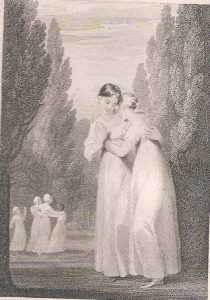
‘Correspondence between a Mother and her Daughter’ by Ann Taylor. 1817
There is something in Margaret which enjoys Mrs Jennings’ and Sir John Middleton’s 18th century robustness, even vulgarity, about love affairs. (Surely, at thirteen, one is allowed to be a bit of a brat.) We know that Margaret is there when Edward Ferrars comes to stay at Barton Cottage for a week, because she suddenly comes out with: ‘I wish,’ said Margaret, striking out a novel thought, ‘that somebody would give us all a large fortune apiece!’ Later, she adds, ‘How happy I should be! I wonder what I should do with it?’
Margaret’s role here is clear: it is to illuminate Marianne and Mrs Dashwood’s characters. Edward picks up Margaret’s wish and suggests how Marianne would spend her money – on books and music. Mrs Dashwood wonders what she would do if her children didn’t need her financial help; Elinor tells her that she has only to think of home improvements to Barton Cottage and she’d have no difficulty in spending the money. The conversation moves on and we never hear what Margaret would do with her fortune.

19th century beaded reticule
Shortly afterwards, Mrs Jennings invites Elinor and Marianne to come at stay with her in London, and Margaret disappears from the story until Elinor and Marianne return to Barton Cottage, shortly towards the end of the book. Then she gets the occasional mention and, when Jane Austen ties up the loose ends, we hear that Sir John Middleton and Mrs Jennings are consoled for the loss of Elinor and Marianne (both now married) by their realization that ‘Margaret had reached an age highly suitable for dancing, and not very ineligible for being supposed to have a lover.’
I confess I don’t find this very satisfactory. Compared with other Jane Austen minor characters, like Kitty Bennet, say, Margaret comes across as pretty one-dimensional. Kitty, in her small way, is a fully realized character; she’s a foil to Lydia, she has her own reactions to Lydia’s behaviour in Brighton, and, as we learn at the end, she is capable of improvement.
Having said all this, I was interested to read Emma Thompson’s 1996 screenplay for Sense & Sensibility amd to see how Emma Thompson deals with Margaret; someone who Jane Austen has decided is a very minor character.
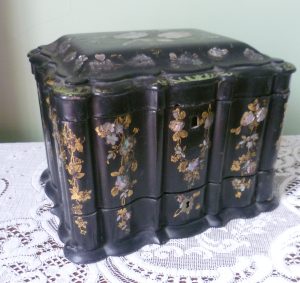
19th century japanware sewing box with paint and mother-of-pearl decoration
Emma Thompson allows Margaret to be a fully-realized character from the beginning and gives her several important jobs to do. The first time we meet Margaret she is a truculent eleven-year-old out of sight in her tree house. In fact, the reader’s interest is roused by having Margaret mentioned as ‘missing’ and we gradually realize that she is in hiding, sometimes up a tree, sometimes under the table.
Margaret’s off-stage presence allows Elinor to tell the viewers various things they need to know, for example, about the dramatically changed family situation once the Dashwood sisters’ father has died. Margaret’s voice over from her tree house asks about John and Fanny Dashwood, the new owners of Norland Park (John Dashwood is Elinor’s half-brother):
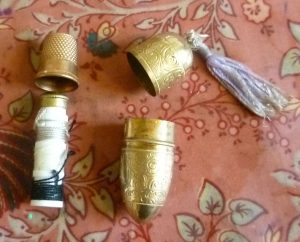
19th century sewing etui
Margaret (V/O): Why are they coming to live at Norland? They already have a house in London.
Elinor: Because houses go from father to son, dearest. It is the law. Silence from Margaret in her tree house.
Elinor: If you come inside, we could play with your atlas.
Margaret (V/O): It’s not my atlas anymore. It’s their atlas.
When we finally meet Margaret, she is a lively girl, who is determined to be a pirate when she grows up. She gets on well with Edward – who teaches her fencing, and, generally, she comes across as a loved and valued member of the family.
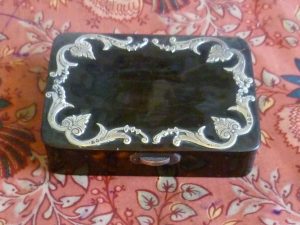
Tortoiseshell trinket box with silver decoration
Interestingly, Emma Thompson notes in her diary – published by Bloomsbury as a companion to the Screenplay – that Emilie François, who plays Margaret, ‘has a natural quick intelligence that informs every movement – she creates spontaneity in all of us just by being there.’ Plainly, Emma Thompson had no intention of allowing Margaret to be just an also ran.
When the family arrive at their new, much more modest home, Barton Cottage, they are greeted by Sir John Middleton and his mother-in-law, Mrs Jennings. What is interesting about Emma Thompson’s depiction of Margaret is that, although she doesn’t have a lot to say, she is always given very precise stage directions. The rest of the Dashwoods are overwhelmed by Sir John and Mrs Jennings’ ebullience, Margaret is ‘clearly fascinated’ by them. ‘I like them’ she declares.
When the Dashwoods are invited up to Barton Park, the stage directions tell us that Margaret is staring at Mrs Jennings as if she were some particularly thrilling form of wildlife. (I can’t help thinking that Emilie François must have thoroughly enjoyed all this.)
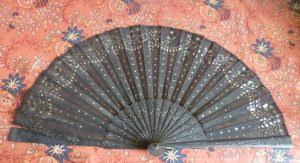
Ebony fan
This is the scene where Margaret spills the beans about Elinor’s young man’s surname beginning with F. The stage directions note that: Mrs Dashwood is appalled at her youngest’s relish for such a vulgar game. Sir John and Mrs Jennings are cock-a-hoop.
The scene comes early on, in Chapter 12, and in Emma Thompson’s screen play, Margaret is already a three-dimensional character. She’s lively, she has her own opinions which she’s not afraid to air, and she perfectly capable of questioning Colonel Brandon about the East Indies. (Stage direction: Margaret is quivering with fascination),
Margaret is particularly useful for getting across the different social mores. Marianne is furious at Margaret for telling Mrs Jennings about Edward Ferrars’s surname beginning with an F; Marianne had obviously told Margaret about Elinor and Edward in confidence – or so she thought.
Marianne: You do not speak of such things before strangers –
Margaret: But everyone else was!
Marianne: Mrs Jennings is not everyone.
Margaret: I like her! She talks about things. We never talk about things.
Margaret, plainly, doesn’t go along with all the buttoned up polite restraint the Dashwoods go in for.

China trinket box
In the scene where Willoughby rescues Marianne, Emma Thompson makes sure that Margaret is present – and reacting. When Willoughby feels Marianne’s ankle to see if it’s broken, Margaret’s ‘eyes are out on chapel-hooks’. When Mrs Dashwood escorts Willoughby out, Margaret ‘pokes her head around the door to watch’. Later, Mrs Dashwood sends Margaret off to ask the maid to make up a cold compress for Marianne’s ankle, we are told that Margaret ‘leaves reluctantly’.
Mind you, Emma Thompson also gives stage directions to the other characters, for example, Mrs Dashwood’s ‘excited expression’ on hearing that her daughter’s rescuer is ‘John Willoughby of Allenham’, the neighbouring big house, and the heir of the aged owner.
What I particularly like about Emma Thompson’s portrayal of Margaret, is that she allows Margaret her own agenda. When Mrs Jennings first invites Elinor and Marianne to London, Margaret is desperate to go, too. She begs Mrs Jennings: Oh, please can I go? I’m twelve soon.
In fact, by making Margaret only eleven at the beginning, instead of Jane Austen’s thirteen, and allowing Elinor and Marianne to be in their twenties, instead of sixteen rising seventeen (Marianne) and nineteen (Elinor), Margaret instantly becomes the ‘after thought’ child, desperate to catch up.
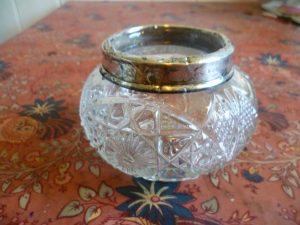
Glass face powder bowl with silver rim
Emma Thompson comments in her diary: I very much like the fact that there are four generations represented in this film – from Margaret’s twelve-year-old perspective through Elinor and Marianne’s twenties and Mrs Dashwood’s forties to Mrs Jennings sixties.
I loved Emma Thompson’s film version of Sense & Sensibility, and I think she thoroughly deserved all the critical acclaim she received.
However, I must end by saying that I am well aware that one cannot really compare a novel with a screen play; it’s like being asked to say which is best: an apple or an orange.. A successful film, like Sense & Sensibility was, above all, a collaborative effort. Yes, Emma Thompson’s screenplay was terrific but so, too, was the film’s director, Ang Lee, not to mention the cameramen, the costume designers, the music etc., and, of course the actors – who were all brilliant.
Next Week, in Part II of my Jane Austen and Sense & Sensibility blog, I will be looking at Joanna Trollope’s 2013 Sense & Sensibility and see how she tackles the character of Margaret Dashwood.
Elizabeth Hawksley
Please share this page...
A fascinating examination, Elizabeth. I do love how you dissect these things and give us fresh insights. I recently read a really good (as well as interesting) novel about Mary Bennet, The Forgotten Sister by Jennifer Paynter. I found it a bit over-long and there was a section which grew a tad tedious, but on the whole a riveting and erudite read and very interesting take on the least attractive of the Bennet girls.
I’m looking forward to your look at Joanna Trollope’s version of S and S.
Thank you for your comment, Elizabeth. I must have a look at Jennifer Paynter’s ‘The Forgotten Sister’. Poor Mary Bennet really does get the short straw. I blame Mr Bennet, myself.
Thank you for this very enjoyable post, Elizabeth. I loved the film of Sense and Sensibility – I thought it was one of the depictions of a Jane Austen novel which accorded it the justice it deserved. One of my favourite scenes takes place while the older Dashwood women are having an earnest conversation inside the cottage; meanwhile in the garden Margaret can be seen taking poor Edward by surprise with some dexterous fencing manoeuvre which he’s no doubt just taught her…
Thank you, Prem, for reminding me of that fencing scene which always makes me laugh. I love the film, too, even though Emma Thompson invents scenes which aren’t in the book – like the fencing scene – nevertheless, she manages to catch the essence of the book extremely well. There are so many brilliant bits of acting, too: Imogen Stubbs is terrific as the ghastly Lucy Steele. and, of course, Alan Rickman is to die for.